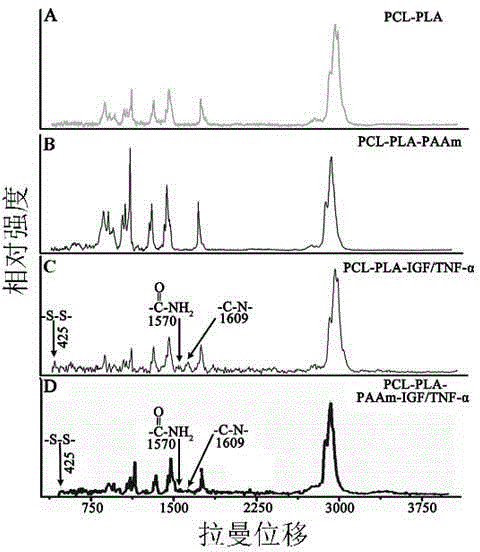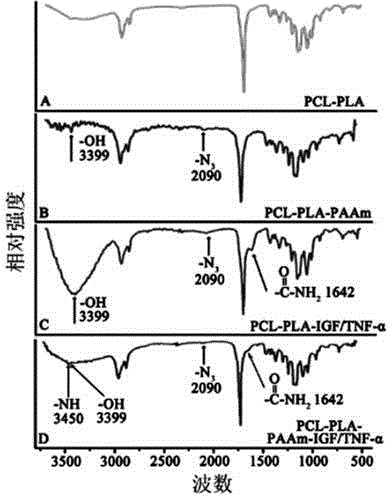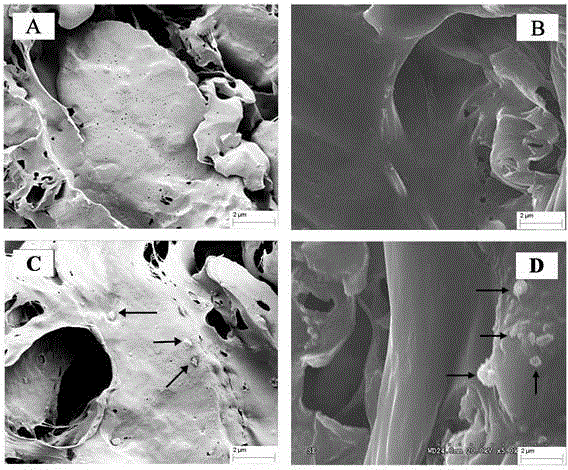Preparation and application of PCL-PLA (polycaprolactone-polylactic acid) tissue engineering composite scaffold with liver cell anti-aging function
A tissue engineering and composite scaffold technology, which is applied in the field of preparation of PCL-PLA tissue engineering composite scaffolds, can solve the problems of cell culture vascularization, immune rejection, xenovirus infection, etc., and achieves improved cell growth state, good anti-aging effect, The effect of significant anti-aging effect on cells
- Summary
- Abstract
- Description
- Claims
- Application Information
AI Technical Summary
Problems solved by technology
Method used
Image
Examples
Embodiment 1
[0067] Example 1 Preparation of PCL-PLA Tissue Engineering Composite Scaffold Against Hepatocyte Aging
[0068] 1. Preparation of free IGF and TNF-a
[0069] Insulin-like growth factor (IGF) and tumor necrosis factor-alpha (TNF-α) were purchased from Zhongshan Third Hospital, and sterile PBS, pipette tips, droppers, reagent bottles, EP tubes, etc. were prepared.
[0070] Dissolve IGF (45 μg, 0.02 μmol) and TNF-α (40 μg, 0.02 μmol) in PBS solution respectively, and after adjusting to a concentration of 1 ng / μl, use a disposable filter membrane (a filter membrane with a pore size of 10,000 Mw) Filter and sterilize them separately to obtain free IGF solution and free TNF-a solution, which are divided into EP tubes and labeled for later use.
[0071] 2. Preparation of co-immobilized IGF and TNF-a
[0072] (1) Add DMF:PBS 4:1 buffer solution on the basis of free IGF and free TNF-a to help it dissolve, add a magnetic stirrer, put it in a magnetic stirrer and stir in an ice bath ...
Embodiment 2
[0083] Example 2 Characterization of PCL-PLA Tissue Engineering Composite Scaffold Against Hepatocyte Aging
[0084] In this example, for the anti-hepatocyte aging PCL-PLA tissue engineering composite scaffold prepared in Example 1, Raman spectrum, infrared spectrum, scanning electron microscope, X-ray Photoelectron spectroscopy and other methods can be used to judge whether the synthesis is successful or not.
[0085] 1. Raman spectral analysis
[0086] (1) Analysis method
[0087] Spectra of Raman scattering. In 1928, C.V. Raman experiment found that when light passes through a transparent medium and is scattered by molecules, the frequency changes. This phenomenon is called Raman scattering , later in the same year at Soviet Union and France was also observed. Scattering in transparent media spectrum Among them, the component with the same frequency as the frequency of the incident light υ0 is called Rayleigh scattering; the spectral line or band υ0±υ1 that is ...
Embodiment 3
[0106] Example 3 Application of PCL-PLA Tissue Engineering Composite Scaffold Against Hepatocyte Aging
[0107] 1. Culture of hepatocellular carcinoma cells (HepG2)
[0108] The source of the cells is the Medical College of Jinan University. The shape of the liver cancer cells (HepG2) is round under the microscope. The culture method of the liver cancer cells is basically the same as that of the human stellate hepatocytes. Use sterile PBS buffer to wash away the cells that are not firmly attached to the wall, digest with PBS(-) solution containing trypsin 0.25% (W / V) and EDTA 0.02% (W / V) for about 2 minutes, add an equal amount of Low-sugar serum-containing DMEM culture medium (containing 10% newborn calf serum, 0.06 mg / ml penicillin, 0.10 mg / ml streptomycin, pH 7.2-7.4), gently pipet with a sterilized dropper, and collect the cell suspension into a sterile centrifuge tube. Centrifuge at 1000 r / min for 5 min. Discard the supernatant and inoculate into culture flasks. Put...
PUM
 Login to View More
Login to View More Abstract
Description
Claims
Application Information
 Login to View More
Login to View More - R&D
- Intellectual Property
- Life Sciences
- Materials
- Tech Scout
- Unparalleled Data Quality
- Higher Quality Content
- 60% Fewer Hallucinations
Browse by: Latest US Patents, China's latest patents, Technical Efficacy Thesaurus, Application Domain, Technology Topic, Popular Technical Reports.
© 2025 PatSnap. All rights reserved.Legal|Privacy policy|Modern Slavery Act Transparency Statement|Sitemap|About US| Contact US: help@patsnap.com



